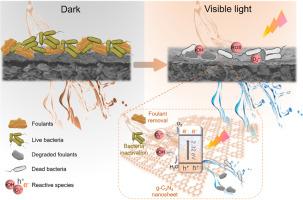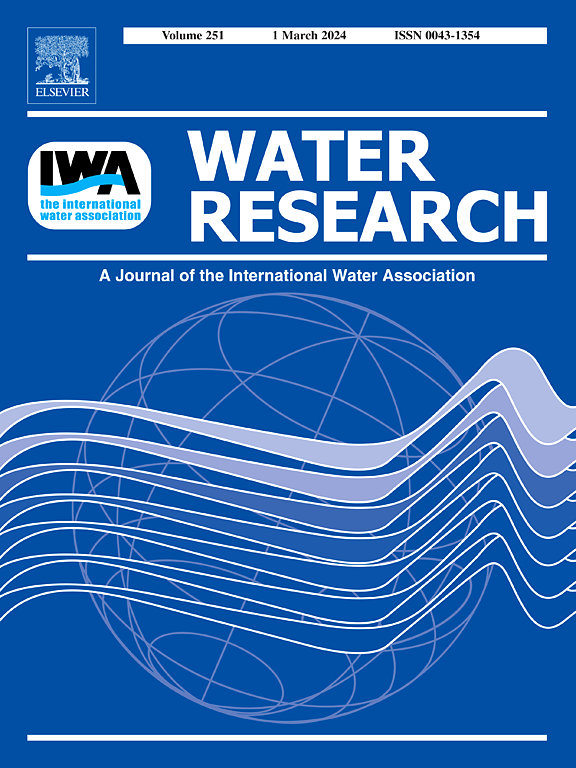Antifouling characteristics and mechanisms in visible-light photocatalytic membrane bioreactor based on g-C3N4 modified membrane
IF 11.4
1区 环境科学与生态学
Q1 ENGINEERING, ENVIRONMENTAL
引用次数: 0
Abstract
A novel visible-light photocatalytic membrane bioreactor (R3) was constructed for membrane fouling control and effluent quality improvement. Specially, g-C3N4 modified membrane was evaluated for the performance of synergistic separation and photocatalysis. Another two parallel reactors, MBRs with ceramic membrane (R1) and g-C3N4 membrane in dark condition (R2), were operated synchronously for comparison. A satisfactory effluent quality was obtained in R3 with COD and NH4+-N around 22.0 mg/L and 1.02 mg/L during 60-day operation, which was superior to R1 (27.8, 1.42 mg/L) and R2 (29.9, 2.26 mg/L). The thickness of cake layer on membranes in R3 (2.46 μm) was thinner than R1 (3.52 μm) and R2 (4.97 μm) after operation, indicating the introduction of visible light could effectively mitigate membranes fouling. Moreover, microorganism community analysis revealed that visible light increased the relative abundance of Bacteroidetes and Chryseolinea, which not only enhanced the activity of microorganisms in metabolizing organic nutrients, but also improved the transfer and utilization of photogenerated electrons on the semiconductor-microorganism interface. The active aromatic protein metabolism and the upregulated related enzymes further demonstrated the synergistic effect of photocatalysis and microbial communities on the membrane fouling mitigation. This work provides a novel application of photocatalysis into antibiofouling effect in MBRs, and opens a strategy for bacteria inactivation and foulants removal with eco-friendly solar energy.

基于 g-C3N4 改性膜的可见光光催化膜生物反应器的防污特性与机理
为控制膜堵塞和改善出水水质,构建了一种新型可见光光催化膜生物反应器(R3)。特别是对 g-C3N4 改性膜的协同分离和光催化性能进行了评估。另外两个平行反应器,即使用陶瓷膜的 MBRs(R1)和在黑暗条件下使用 g-C3N4 膜的 MBRs(R2)也同步运行,以进行比较。在 60 天的运行过程中,R3 获得了令人满意的出水质量,COD 和 NH4+-N 分别为 22.0 mg/L 和 1.02 mg/L,优于 R1(27.8,1.42 mg/L)和 R2(29.9,2.26 mg/L)。运行后,R3(2.46 μm)膜上的滤饼层厚度比 R1(3.52 μm)和 R2(4.97 μm)薄,表明引入可见光能有效缓解膜堵塞。此外,微生物群落分析表明,可见光增加了类杆菌和褐藻的相对丰度,这不仅提高了微生物代谢有机营养物质的活性,还改善了光生电子在半导体-微生物界面上的转移和利用。活跃的芳香族蛋白代谢和相关酶的上调进一步证明了光催化和微生物群落在减轻膜污垢方面的协同作用。这项工作提供了光催化在膜生物反应器中抗污效果的新应用,并开辟了一种利用环保太阳能灭活细菌和去除污物的策略。
本文章由计算机程序翻译,如有差异,请以英文原文为准。
求助全文
约1分钟内获得全文
求助全文
来源期刊

Water Research
环境科学-工程:环境
CiteScore
20.80
自引率
9.40%
发文量
1307
审稿时长
38 days
期刊介绍:
Water Research, along with its open access companion journal Water Research X, serves as a platform for publishing original research papers covering various aspects of the science and technology related to the anthropogenic water cycle, water quality, and its management worldwide. The audience targeted by the journal comprises biologists, chemical engineers, chemists, civil engineers, environmental engineers, limnologists, and microbiologists. The scope of the journal include:
•Treatment processes for water and wastewaters (municipal, agricultural, industrial, and on-site treatment), including resource recovery and residuals management;
•Urban hydrology including sewer systems, stormwater management, and green infrastructure;
•Drinking water treatment and distribution;
•Potable and non-potable water reuse;
•Sanitation, public health, and risk assessment;
•Anaerobic digestion, solid and hazardous waste management, including source characterization and the effects and control of leachates and gaseous emissions;
•Contaminants (chemical, microbial, anthropogenic particles such as nanoparticles or microplastics) and related water quality sensing, monitoring, fate, and assessment;
•Anthropogenic impacts on inland, tidal, coastal and urban waters, focusing on surface and ground waters, and point and non-point sources of pollution;
•Environmental restoration, linked to surface water, groundwater and groundwater remediation;
•Analysis of the interfaces between sediments and water, and between water and atmosphere, focusing specifically on anthropogenic impacts;
•Mathematical modelling, systems analysis, machine learning, and beneficial use of big data related to the anthropogenic water cycle;
•Socio-economic, policy, and regulations studies.
 求助内容:
求助内容: 应助结果提醒方式:
应助结果提醒方式:


